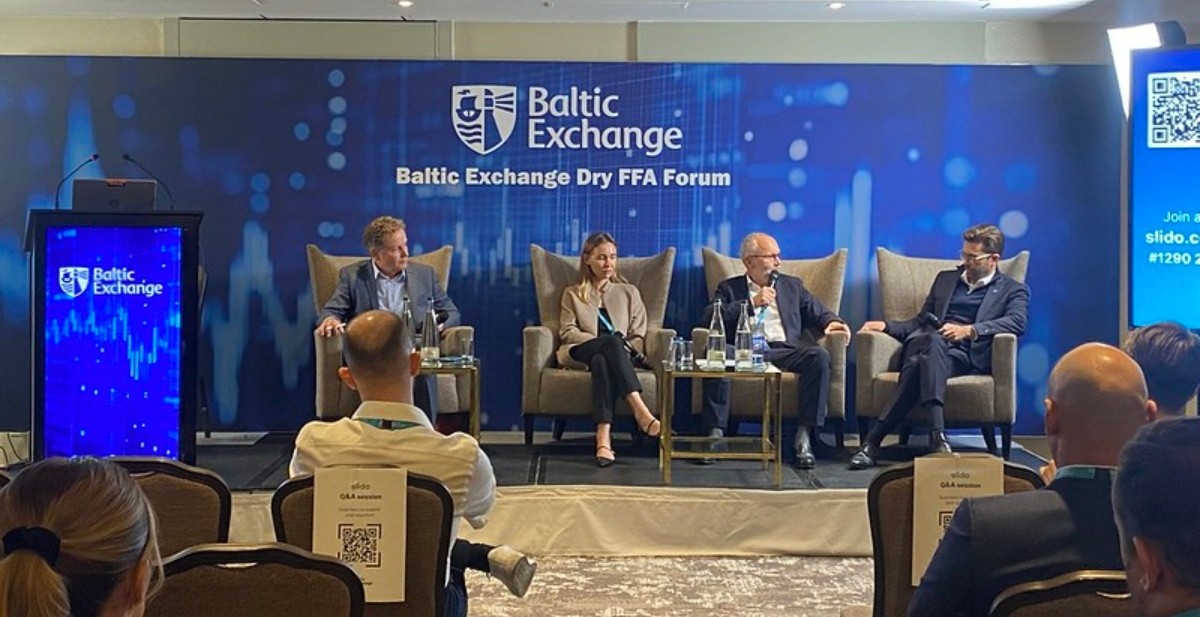Decarbonisation deadlocks

Fuel chaos, regulatory gaps, and the widening equity divide
By Carly Fields
The path to maritime decarbonisation, while technologically feasible, remains beset with regulatory fragmentation, acute contractual uncertainty, and a critical shortage of human capital investment, according to a panel at the Baltic Exchange Dry FFA Forum in October.
The conclusion among the speakers was clear: while ships are increasingly prepared for a cleaner future, the fuel, the framework, and the global infrastructure are lagging behind.
The Emissions Panel, led by Martin Crawford-Brunt, carbon lead at the Baltic Exchange, brought together Benoit Viel, global head of sales for medium, low speed and rail at Accelleron; Ryan Bax, lead consultant at Lloyd’s Register; and Liliane Flour, programme manager at UNCTAD, for an assessment of the dry bulk sector’s evolving emissions landscape.
The discussion highlighted the ethical and practical challenge of a “just transition”. UNCTAD’s Flour framed the necessity of a global approach, warning that the current dynamic is leaving the developing world behind.
“I guess you can say a just transition at the UN would mean a globalised approach to reforms in the way we approach shipping,”
she said. She added that the widening gap is creating difficulties for all parties: “Human capital investment is really necessary, both across the developed and the developing world, especially now with digital and energy transition.”
Chaos of compliance
For shipowners and operators, the immediate pressure is regulatory compliance, particularly with the European Union’s Emissions Trading System (ETS) and FuelEU Maritime initiatives. LR’s Bax said that the process has been a “steep learning curve for a lot of the owners and the operators” that LR works with, citing messages received just weeks prior to the event from companies admitting, “we haven't set up our ETS account yet.” He said that while the chaos surrounding ETS was significant, the complexity of FuelEU, which revolves around fuel choices, presents an even greater operational and financial challenge.
The contractual complexity, however, appears to be the most overlooked danger zone. Bax noted an alarming trend in charter party negotiations. “One of the big areas of discussion and confusion is working with these BIMCO clauses,” he explained. He said that he has worked with companies where they set up their BIMCO clauses but “not actually requiring any actions in terms of the charterer for achieving compliance”. While this might “look fine at face value for the first year”, he said that if the accountability for non-compliance is not clearly defined annually, “that shipping company is going to incur that penalty multiplier, and there doesn't seem to be any accountability for that at this stage from a lot of companies.”
The complexity of fuel choice extends beyond pricing and regulation and into genuine technical pitfalls.
Biofuels were identified as an essential component, necessitating that “charterers are going to have to take a leading role in terms of utilising biofuel for their voyages.”
However, even this necessary alternative brings operational issues. Crawford-Brunt likened the risk to dilution: “It brings operational criteria. The best way somebody described it is it’s like somebody adding water to your beer.” He explained that an engine is highly sensitive to the change and that it “starts to taste the difference”. This introduces a contractual disparity, as the ability to pull and burn the biofuel immediately becomes an operational priority: “You don't want to leave it in your tanks.”
Ships are ready, fuel is missing
Accelleron’s Viel added that while the technology on the shipbuilding side is advancing rapidly, fuel supply is failing to keep pace. “A big amount of newbuilds are with dual fuel engines, ready to use new fuels. More than 50% last year were newbuilds with DF engines,” Viel said. “The ships are ready. The fuel is missing.”
Viel attributed this gap to several “deadlocks”, including uncertainty about which net-zero fuel—methanol, ammonia, or LNG—will ultimately prevail, and the immense cost of producing these alternatives at scale. He also pointed out the regulatory fragmentation, noting that while a “global IMO framework” exists, regional regulations like Europe's create "stretch and gaps that needs to be... closed, to help driving investment”. Furthermore, he foresaw market competition for scarce biofuel: “We could imagine that aviation has more power to buy this kind of expensive fuel than shipping, which is used to buying the leftovers.”
Amid these macro challenges, the panel agreed that energy efficiency measures offer a critical, immediate, and economically sound first step. Viel championed efficiency retrofits, saying:
“Whatever energy efficiency measures you implement today with the current fuel price, they will pay off even more when the fuel gets more expensive.”
He said that the widespread adoption of measures such as hull lubrication and wind assist propulsion could realistically help the industry achieve the IMO 2030 target.
Port and people problem
However, even proven efficiency technologies like wind assist create unforeseen friction points at the infrastructure level. Bax explained the highly technical challenge, explaining that an existing vessel is taken “out of its design envelope” by retrofitting wind, which can sometimes increase drag rather than reduce it. He also highlighted that a seemingly small operational error—a five-degree leeway while sailing with wind—"can actually reduce your efficiency by 22%,” underscoring the need for specialised crew training.
Flour brought the discussion to the terminal side, pointing out that initial assumptions about port readiness were incorrect. She recalled an early presentation on sail-testing where she asked about the impact on ports and received the answer, “Oh no, it’s fine. They don’t need to know anything.” Now, the industry is waking up to the reality and terminals are saying, “‘No, you can’t come in here.’” Flour explained that port operators are less worried about the vessel and more about damage to their equipment, “because that shuts down the terminal, and that’s a loss that they can’t handle”. This issue is amplified in developing countries, where equipment breakdown is a “real loss” that causes supply chain disruption.